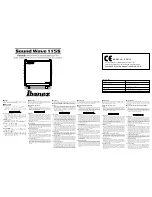
© Miller Diving All Rights Reserved Document # 030715001
8
SECTION 2
OPERATING INSTRUCTIONS AND PROCEDURES
8. To test for external water leaks: Connect Helmet to
gas supply., Close both exhausts, lightly open Free Flow
Valve , submerge Helmet, upside down in tank of water,
just covering neck ring. Keep Neck Seal above water,
pinched together with one hand. Rising air bubbles in
the water will indicate any leaks. Correct with new O-
ring and silicone sealant. A small leak from Exhaust
Handle is normal.
WARNING: In the event the Helmet is to
be used with pure oxygen (such as 02 decom-
pression) the entire Helmet must be clean and
free of any type oil or grease which could ignite.
Only silicone type oxygen compatible lubricants
may be used.
NOTE: It is recommended that the diver fully acquaint
himself with all valves, components, and accessories
in a training tank or shallow water, before making a
working dive.
2-B
DRESSING INTO THE MILLER HELMET
Check for proper adjustment. The Head Harness is eas-
ily adjusted by moving the Adjustment Buttons. Do not
over tighten. The Upper Mounting Washer and Screw
have three adjustment holes in the upper pad which will
change the angle of position on the head.
Pull Neck Ring and Neck Seal over the head with-the
Screw heads facing down. The Neck Seal should be
turned down and may be tucked into the wet suit jacket.
2-A
PRE-DIVE PROCEDURE:
1. Inspect Helmet shell for any damage or loose valves
or fittings.
2. Inspect all rubber parts for wear, cracking, and proper
installation.
3. Inspect exhaust valves to see that they are free of for-
eign matter and in good condition.
4. The Helmet should be hooked up to a suitable gas
supply and all valves & exhausts checked for proper func-
tion as follows: Open Free-flow Valve to assure suffi-
cient airflow. With Free-flow Valve closed, ascertain that
the Demand Regulator is breathing properly. Inspect each
exhaust valve by opening and closing it while Free-flow
Valve is open.
5. Test radio communications by talking both to and from
the diver.
6. Test Non-return Check Valve for proper function with
at least one of the following :
Ist test: This test must be made with Free-flow Valve
open and the supply umbilical removed from Helmet.
Place your mouth on inlet fitting and suck while placing
tongue over orifice. The tongue should stick, due to the
vacuum created if the check valve is operating properly.
If the tongue does not stick, or air can be sucked out of
valve, there is a leak and it must be corrected before
diving.
2nd test: This test must be made with Free Flow Valve
closed and the supply umbilical removed from Helmet.
Disconnect the Demand Tube from Regulator Inlet Fit-
ting. Attempt to blow in end of tube. It should be impos-
sible if check valve works and all connections are tight.
3rd test: The Check Valve must be removed from the
Helmet and supply umbilical. Test by attempting to blow
against arrow direction. It should be impossible (no leak-
age) if valve is functioning correctly.
7. Verify emergency gas cylinder is full to rated capacity
and is properly connected to Helmet.
With the tender holding the Helmet in a convenient posi-
tion, the diver places both thumbs on the lower pad, stretch-
ing it back and open. The back of the head is inserted first
and the Helmet is then
rolled down over the face.
The Neck Ring is inserted
into the Helmet and the
Cam Handles are closed.
Then the buckle halves of
the positive locking straps
are pulled forward and
snapped together, locking
the cams.









































